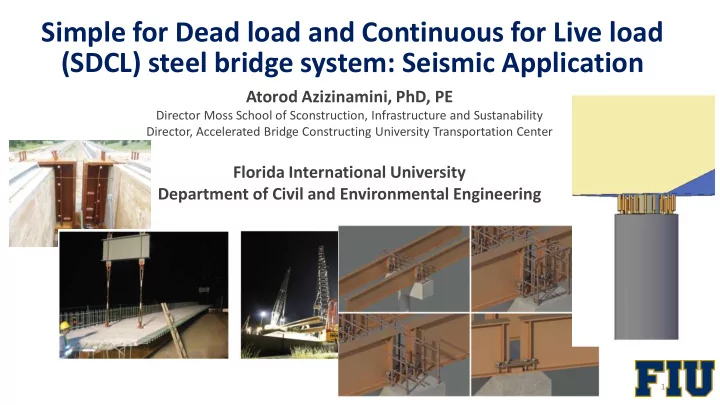

Simple for Dead load and Continuous for Live load (SDCL) steel bridge system: Seismic Application Atorod Azizinamini, PhD, PE Director Moss School of Sconstruction, Infrastructure and Sustanability Director, Accelerated Bridge Constructing University Transportation Center Florida International University Department of Civil and Environmental Engineering 1
Brief Introduction to Simple for Dead Load and Continuous for Live Load Steel Bridge System (SDCL)
Conventional Method
Conventional Method
Conventional Method
Conventional Method
Conventional Method Conventional Method
SDCL
SDCL
SDCL
Longitudinal Reinforcement Is Placed in the Deck for Live Load Continuity 11
SDCL
M+ Increases M- Decreases No Bolted Connection Ease of Construction Enhanced Service life Minimized Traffic Interruption 13
PIER DETAIL
WELDED BOTTOM FLANGE Test 1
NO END PREPARATION Test 2
Test 3 END CAP PLATES
19
FIELD DEMONSTRATION BRIDGE 20
23
y y P i P i P P i i F c F c F F c c T T T T z z C C C C x x
Mn = As fy ( d − H /2) (1) Based on Research Where: Mn = Moment Capacity As = Area of Slab Reinforcement (Tension) fy = Yield Stress of Reinforcement d = Bottom of Girder to Slab Reinforcement H = Height Steel Block 25
Calculation for Test Specimen: W40×249 Two Span Bridge – Each Span 97 Ft D = 43.375 in bf = 15.75 in Mu (LL) 34,770 in.-kip (Required) Slab Width be = 92 in. (effective) Slab Thickness t = 8.5 in. Distance to Reinforcement, d = 47.75 in. Strength reduction factor, ϕ = 0.9 26
Rearrange Capacity Equation: Using Sample Values: 27
Bearing Check: Max Bearing Stress (Steel Block) = 1.7 Fy Equate Tension (T) and Compression (C) Components to Determine Minimum Height of Block to Resist Tension in Reinforcement (2 in. used in specimen) Note: Block Width = Flange Width ( bf ) 28
Other Details Used in Practice
30
31
32
33
SDCL Application Example Non-Seismic
Temporary Bracings were not used
System Greatly Reduces Falling Hazard
SDCL: ABC Application Non-seismic Longitudinal Cope Top Flange Reinforcement Deck Girder Bearing Blocks 37
42
43
44
Moderate to High Seismic Detail: SDCL
Types of Forces, Seismic Detail Should Resist 53
Seismic Detail 54
Seismic Detail 1. Tie bars and shear studs on the compression flange 5 2. Steel blocks at the end of the compression flanges 3. End stiffeners 3 4. Dowel bars 4 1 5. Live load continuity 2 reinforcement 55
ABC Application of SDCL Using Envisioned Connection
Column to Cap beam Connection 1 2 3 Precast Cap-beam UHPC Concrete Filled UHPC Tube
Construction Sequence Precast Cap beam Connecting Shell to Casting Column Connecting Column to Footing and Precast UHPC Placing Shell Footing (Normal Concrete) Cap beam Column Shell as Formwork (UHPC) (UHPC) reinforcement
59
Note: Reverse Curvature for Multiple Columns 60
Component test Design of Test Specimen Inverted setup 61
Component test Test Setup 62
Component test Design of Test Specimen Capacity Design using M- ϕ and finite element analysis p M- ϕ in Column M- ϕ Be Bent t cap n Bent Be t cap p M- Δ in n longitu tudin inal l Col transver erse e di directio ion di directio ion (FE FE) 63 (Separate Check at Face of Cap – Dashed line)
Component test Design of Test Specimen AASHTO Seismic Guide Spec 64
Component test Design of Test Specimen AASHTO Seismic Guide Spec Not shown 65
Component test Design of Test Specimen AASHTO Seismic Guide Spec 66
Component test Design of Test Specimen Joint Shear Reinforcement Detail Parameter Required Provided Description 𝑩 𝒕𝒖 3.72 3.72 Column Longitudinal 12 #5 Vertical bars 𝒌𝒘 0.744 0.88 & 0.77 𝑩 𝒕 8 #3 for area 3 and 4, 7 #3 for area 1 and 2 Horizontal bars 𝒌𝒊 𝑩 𝒕 0.37 0.88 2 set of 4 #3 on each side of column Side bars 𝒕𝒈 0.2 0.33 𝑩 𝒕 67 3 #3 each side
Component Test Setup 68
Component testing (Plastic Hinge Damage) 1Δ y 2Δ y 3Δ y Crushing 4Δ y 5Δ y 6Δ y Cracking Structures Congress 2019 69 Orlando, FL | April 24-27
Component testing Strain and Curvature Measurements (Column) 1Δ y 2Δ y 3Δ y 4Δ y 30 Strain (x10-6) Distance from Cap-beam (cm) 0 5000 10000 15000 25 30 Distance from Cap beam (cm) 20 20 15 10 10 0 5 -10 0 -20 -0.4 -0.2 0 0.2 0.4 Curvature (rad/m) Steel yield strain 1Δ y 2Δ y 3Δ y 4Δ y 5Δ y -30 Structures Congress 2019 70 Orlando, FL | April 24-27
Component testing Strain Measurements (Cap beam) 1000 Strain (x10 -6 ) 500 0 0 20 40 60 80 Distance from column centerline (cm) 1Δ y (Experimental) 6Δ y (Experimental) 1Δ y (Numerical) 6Δ y (Numerical) Structures Congress 2019 71 Orlando, FL | April 24-27
Component testing Strain Measurements (Deck) Structures Congress 2019 72 Orlando, FL | April 24-27
73
74
Conclusions: - Details and associated design criteria are developed to apply the SDCL steel bridge system to moderate to high seismic areas. - The recommendations are verified through shake table test. - The suggested seismic detail is slightly different than non-seismic detail that has been used for more than 15 years successfully. - The recommended design provisions matches those already in AASHTO seismic design specifications.
Recommend
More recommend